
Barbara Bacon
bbacon@canterburyfortmyers.org
Canterbury School, Fort Myers, Florida
| HOME |
| LESSON 1 |
| LESSON 2 |
| LESSON 3 |
| LESSON 4 |
| RESOURCES |
LESSON 4 - HINDU GODS ACTIVITY
RATIONALE
Connecting to a student’s personal world can help to clarify aspects of Hindu belief and practice.
PURPOSE
To extend understanding of the polytheistic nature of Hinduism.
MATERIALS
Paper
Markers, colored pencils
PROCEDURE
Read or paraphrase this quote from Stephen Huyler's book SEEKING GOD:
"As they worship, almost all Hindus direct their prayers to several deities, either at once or individually, attuning themselves to those aspects of the divine essences that they find pertinent to their own needs. For example, each profession has a patron deity who, if properly honored, is believed to facilitate success. Craftsmen pray to Prajapati or Vishvakarma, the progenitor and God of Creativity. Farmers pray to the Earth Goddess Bhudevi or Gauri for fertility and good harvests. Most shops have within them a shrine to the Goddess Lakshmi in order to attract prosperity. Teachers, dancers, and musicians honor Saraswati, the Goddess of learning and the Arts. Soldiers might pray to Rama or Hanuman for might in battle or to one of the many forms of Shakti (for example, Durga or Kali) for her supreme strength and undefeated power. A cook honors Annapurna, the Goddess of Culinary Arts. A pregnant woman may pray to the Goddess Parvati or the Goddess Mariamman to ensure a successful childbrith." (p. 33)
Ask students to consider a skill that they have that they would like to improve. This could be in athletics, performance, academics, home, etc. Have them imagine a god that can help them with this improvement.
Have students create a detailed drawing of this imaginary, personal god. Include 3-5 items that the god is holding, touching, or using. These items should be connected in some way to the skill that the god influences.
Have students create a story about this god. The story should include not only the god's name but an event where the skill was successfully used/achieved/conquered.
Ask students to share these stories when finished.
Establish a connection between these stories and polytheism and Hinduism.
Have students research a particular Hindu god whose powers might be desired by themselves or someone in their family. Assign a writing requirement describing the god, his/her powers and a connection to the student’s personal life. A visual should be included in the assignment.
ASSOCIATED VISUALS
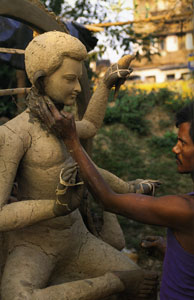 |
"A potter lovingly sculpts a large unfired clay image of the Sun God, Surya, in preparation for the Chhattha Festival. Once the image has dried, it will be painted in brilliant polychrome colors, dressed, and placed in a tented temporary shrine at a main intersection for the entire community to worship." (Huyler, 191) |
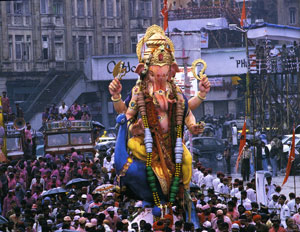 |
"For the culmination of the Ganesha Chaturthi Festival, ephemeral images of the elephant-headed God, big and small, community and household, are carried in procession to a water source to be immersed and dissolved." (Huyler, 203) |
 |
"In Mumbai, they are taken to the sea." (Huyler, 203) |
 |
Another view of the Ganesha festival. (Huyler, 203) |
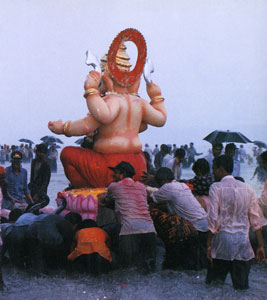 |
And another view. (Huyler, 203) |
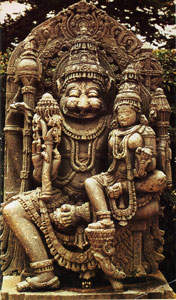 |
"Nara-Simha, one of the avataras of Lord Vishnu." (Younger, 56) |
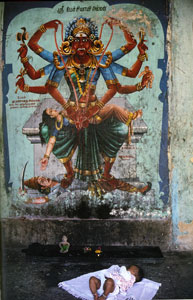 |
"The image of the Goddess Kali...in her form of raging power is often difficult for non-Hindus to understand. However, her devotees consider her protective and nurturing. No mother would willingly place her newborn child in front of anything that she found threatening. This baby has been brought here to instill her with the Goddess's strength. The mural depicts the Goddess disemboweling evil in the guise of beauty." (Huyler, 144) |
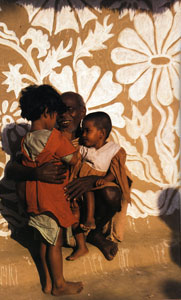 |
"Hindu society pivots on belief in the sanctity of the family: one's family is everything. Relationships between family members are of primary importance, and cherished values are passed down from generation to generation." (Huyler, 39) |